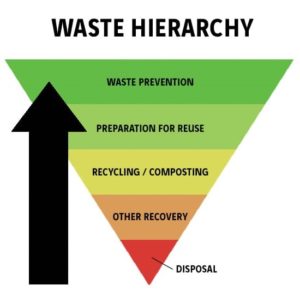If you’ve had a little browse of our website, you may have come across our slideshow (https://parkersskips.com/skip-waste-recycling/) where we discuss the process of recycling the heavy fraction that we receive from the skips including soil, stones, aggregates, mixed with all sorts of other stuff like bits of plastic, wood, metal etc. In said slideshow, we explain that by using our plant, – designed and engineered by our directors and site engineer Stevie – we can extract contaminant waste types for recycling from this mixed, heavy fraction. We’re able to extract bits of wood, plastics, even small nails from this material, leaving clean screened soil, small aggregate and large aggregate.
More recently, our directors and engineers have modified another area of the site to improve the procedure for recycling the lighter waste elements that we get from skips, namely house clearances and commercial and industrial waste. This waste doesn’t tend to have a lot of soil or rubble in it and is instead comprised of lighter waste types you get from office/home clearances or refurbishments, such as furniture and household items.

The first step in the recycling procedure is the same, a skip is tipped in a bay, and it is only tipped once the bay has been completely cleared from the previous skip – we do not allow waste to pile up at this site!
In this initial pre-sort, an operative in a 360 grab removes large bulky items from the waste for recycling (e.g. large bits of wood, cardboard, mattresses, big bits of furniture or metal). What is left after this procedure is a pile of small mixed waste. Instead of just shredding this material and then sending it to produce Refuse Derived Fuel (RDF) for heat and electricity generation, this material will be fed into a new area on site that is specialised for screening lighter waste for recycling.
This involves feeding material into a 3m trommel linked to a picking line which allows us to remove additional small recyclables from the waste stream, that would not easily be removed during the macro pre-sort. This process allows us to extract items such as small bits of wood (e.g. photo frames), metals (e.g. such as an old hole punch), small cardboard boxes and other miscellaneous, recyclable household items.
By carrying out this process, these items are now able to be recycled further up the waste hierarchy, rather than being sent to waste to energy (a process known as recovery).
Waste recovered as an energy source is a much better option than disposal to landfill, and as a zero waste to landfill company we already achieve this. However, there are still better options than waste to energy. These slight modifications to our procedures have allowed us to achieve better than waste recovery for a number of waste types that would otherwise be difficult to extract. We are continually striving to move our waste treatment options further up the waste hierarchy, a process designed to conserve resources and ultimately achieve the most sustainable waste management possible.
